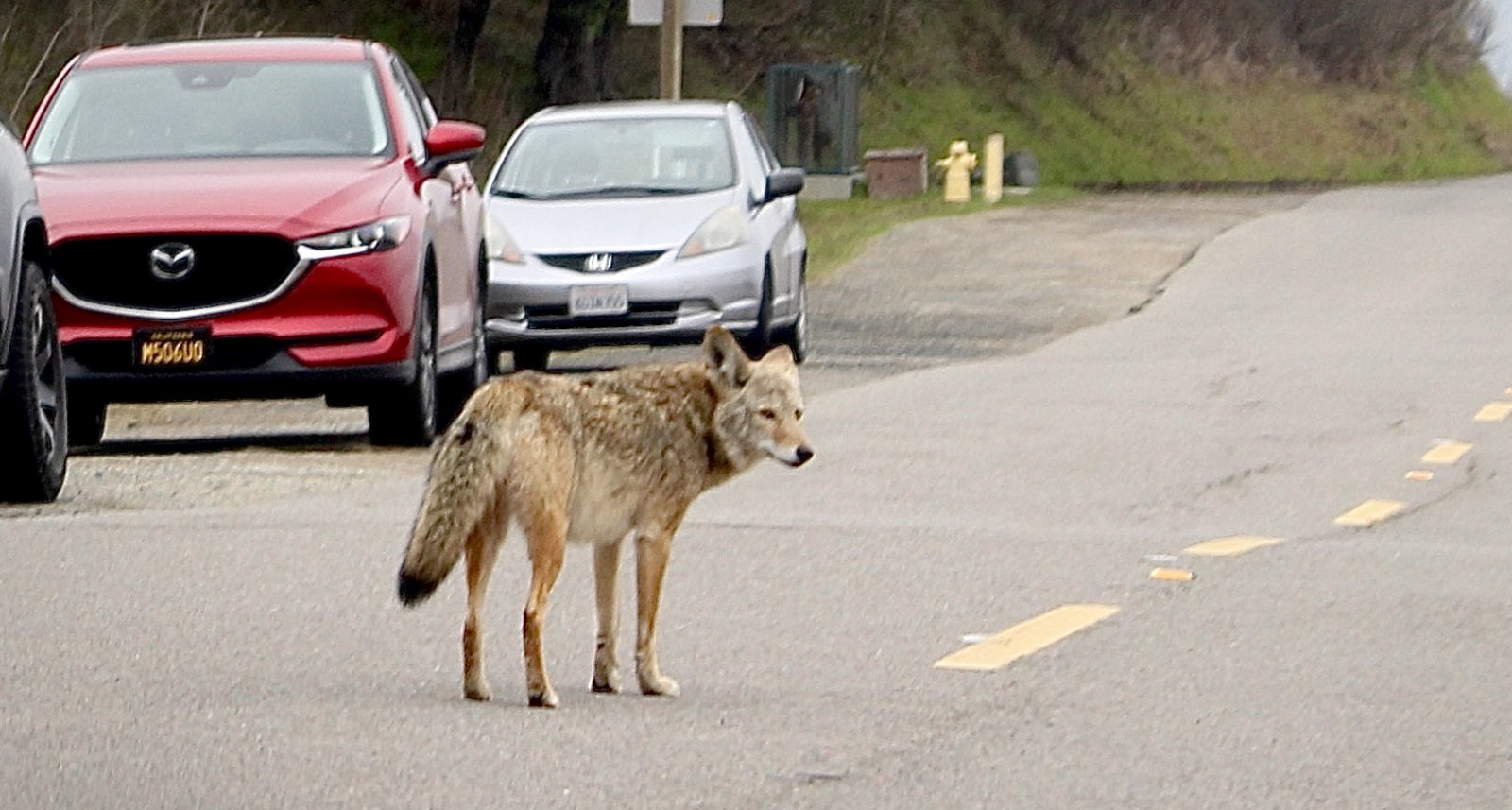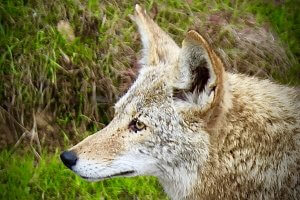
Living safely with coyotes
See how you score on myths and facts about our native wild canines.
With their haunting howl and yellow-eyed stare, coyotes capture the essence of wildness. But in China Camp and in adjacent open space and neighborhoods, some of these lanky and intelligent native canines have become alarmingly habituated to humans, putting the coyotes—as well as people and their pets—at risk.
According to experts, it’s all in the name of food. Coyotes are often spotted lingering around China Camp’s trailheads, pullouts, parking lots, and anywhere people congregate. Though they might look distressed, they’re likely waiting for handouts as people on foot and in cars toss out treats to lure animals ever closer, often in the name of that perfect Instagram post, or because they think these naturally lean animals need the food.
But that could spell doom for the animals. “Based on scientific studies, cars are a leading cause of coyote deaths,” explains Camilla Fox, Founder and Executive Director of Project Coyote, a Marin-based national organization aimed at increasing coyote education and awareness.
At WildCare, a wildlife rescue facility in San Rafael, 10 to 15 coyotes get treated each year, and “almost always because they’ve been hit by a car,” notes Melanie Piazza, the facility’s Director of Animal Care.
“Coyotes are naturally wary and shy,” says Piazza. “But if you’re getting a coyote used to approaching humans and cars for food, you’ll ultimately be contributing to the coyote’s death.”
Fox of Project Coyote stresses that coyotes and other wildlife need nature’s diet to be healthy. “Human food is ‘junk food’ for wildlife,” she explains. “Your well-intentioned handouts may cause disease, injury, and even death.”
When handouts and food waste are left next to a busy road, coyotes risk getting in the path of an oncoming car or cyclist. “There’s a pair of coyotes that hangs out on the road at a blind curve near Pantoll Station in Mount Tamalpais State Park,” says Fox. “Pretty soon they’re going to get hit.”
Feeding coyotes also increases the risk of humans getting nipped or scratched. Even if the coyote doesn’t bite someone, if they continue to approach people in the parks, the county could be required “to trap and euthanize the coyotes in the interest of public safety,” says WildCare’s Piazza.
Fox agrees. “It’s another reason not to feed a coyote. If you feed it and it nips you, you’ve just signed the animal’s death sentence.”
Fortunately, there are ways we can help coyotes—and other wildlife—stay truly wild. Here are seven smart steps:
1. Never feed coyotes. Their life, as well as the safety of you and your pets, depends on coyotes staying wild and naturally wary of humans.
2. Keep human food attended or stashed away. If you have to leave food at camp, store it in lockable coolers or other containers. Never leave food in parked cars with windows open.
3. Throw all food waste and wrappers in proper containers. To really make a difference, especially at China Camp where almost all the work is done by volunteers, carry a small garbage bag and gloves so you can pick up trailside trash.
4. Don’t throw food out your car window. Even banana peels, eggshells, and other biodegradable food waste can attract mice and other critters, which can in turn attract predators—all dangerously close to traffic.
5. Resist the temptation to toss out treats for photos. We’ve had reports of at China Camp of photographers lying on their bellies right in front of coyotes. Don’t do it.
6. Keep pet foods—and your pets—safely indoors. If you see others leaving out kibble or other food, report it to the Marin Humane Society, (415) 883-4621.
7. Leash your dog. Never let pets roam off-leash in parks or open space areas, particularly during pupping season (April to August) when coyotes may be more aggressive to protect their young.
For more tips on coexisting with coyotes, go to Project Coyote . Also watch Marin Humane Society’s video on coexisting with coyotes.—by Harriot Manley, FOCC Volunteer
QUIZ: MYTHS & FACTS ABOUT COYOTES

Test your coyote smarts with our true/false quiz, with answers from coyote experts Camilla Fox, Executive Director of Project Coyote, and biologist Melanie Piazza, Director of Animal Care for San Rafael’s WildCare wildlife rescue and rehabilitation facility.
Coyotes make the most noise when they’re hunting, or after they’ve made a kill. The more noise, the larger the kill.
False. The concept, says WildCare’s Melanie Piazza, “makes no sense in the animal world. When you’re trying to catch your dinner, you don’t announce it or you’re going to lose your prey, and if you catch it, you’re going to keep quiet so other predators and scavengers don’t steal your food.”
So why the racket? “Coyotes can be extremely vocal with each other—more like rowdy teenagers than a pack of vicious killers,” says Piazza. Groups are usually tight-knit family units, and they greet each other with yips and barks, or howls to announce their whereabouts to neighboring packs.
If you’re walking your dog on a trail and you see a coyote watching or following you, the rest of the pack is probably hiding in the bushes, waiting to ambush you.
False. “There’s no scientific evidence to back this up,” states Project Coyote’s Camilla Fox. “Coyotes are usually solitary foragers, not ambushers,” she explains. Fox does note that during pup-rearing season (April through August), coyotes that seem to be following you may in fact be trying to escort you and your dog away from a den site.
Coyotes are naturally timid.
True. “When we get a coyote at the WildCare hospital, they’re incredibly timid, cowering in the back of their cages,” says Piazza. “They’ll defend themselves,” she adds, “but they won’t attack,” she adds, noting that, in the U.S., there have only been eight recorded coyote attacks in the last century. “They do not become bold towards humans until they are taught to do so by humans.”
Coyotes can carry and transmit rabies and other diseases.
True. “Technically any warm-blooded animal can contract rabies,” notes Fox. “But in our area, our primary vectors are skunks and bats, not coyotes.” In fact, rabies in coyotes is extremely rare: according to a 2016 report from the California Department of Public Health, between 1986 to 2015, only eight rabid coyotes were reported in all of California.
Coyotes can also catch distemper. Canine distemper cannot spread to humans, but it can spread to dogs (though they can be vaccinated against it). In wild animals, distemper can start with cold symptoms and lead to “loss of appetite, lethargy, gastrointestinal distress, muscle twitches, paralysis, and death. The virus tends to flare up for a few years—often spread by communal water sources such as bird baths, and then die down. Consider this your reminder to make sure your pets are up to date on vaccinations.
If you see a scrawny coyote, it’s probably sick or starving, and it’s okay to leave out dog kibble or other food for it.
False. Coyotes in our region can be surprisingly slim, averaging just 18 to 35 pounds (roughly the same as a cocker spaniel). “Leaving out food is one of the primary causes of conflicts between coyotes, people, and pets,” says Piazza, “and it can attract rodents and other pests.” That can prompt neighbors to put out poisons, which continues to harm animals up and down the food chain. “Humans who think they are helping by feeding wildlife because they ‘love’ them are in fact doing harm,” says Piazza. If you really love wildlife, do NOT feed them.”
There are way too many coyotes in Marin.
False. “The coyotes have always been here,” says Fox of Project Coyote. “But now, as we’ve moved into their habitats, they’ve learned to live with humans, and we see them more.”
But that, she explains, might not sit right with everyone. “Some people might think it’s exciting to have coyotes denning in their community; others might find it terrifying.”
Instead, she explains, her organization aims to help people understand the benefits of coyotes—how they eat large numbers of rodents and other pests, and how they help keep our ecosystems vital, healthy, and clean.
“We aim to replace fear with understanding, tolerance, and appreciation, and to explain the importance of keeping wild animals, including coyotes, truly wild. It’s our responsibility to do what we can to mitigate negative encounters with our wild neighbors.”
For more tips on coexisting with coyotes, go to Project Coyote.—by Harriot Manley, FOCC Volunteer

